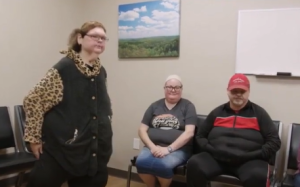The Unfinished Journey: Why Chris Combs Is Hesitant About a Second Skin Removal Surgery
In the world of 1000 lb Sisters, Chris Combs has emerged as one of the most inspiring stories of transformation—a man who defied the odds, shed hundreds of pounds, and finally achieved a body that reflects his incredible dedication. His weight loss journey, vividly documented over seasons, showcases not just the physical change but also the emotional resilience behind it. Yet, even after an impressive initial surgery that removed excess skin and made him look and feel like a new man, Chris finds himself facing an unexpected internal struggle: why is he hesitant to go through another skin removal procedure? This intriguing dilemma raises questions about the often overlooked emotional and physical tolls of massive weight loss surgeries, revealing that the journey to health and happiness extends beyond just shedding pounds.
Chris, 44, began his transformation weighing over 400 pounds, inspired by the support of his famous sisters, Amy and Tammy. His determination paid off when he lost over 200 pounds, qualifying for skin removal surgery—a critical milestone that symbolized not just weight loss but also newfound confidence. During season 6, he bravely underwent the procedure, removing the excess skin around his stomach, which drastically improved his appearance and self-esteem. The transformation was so remarkable that Chris was eager to share his renewed outlook, joking happily about how small his belly button would now be and showing off his flat stomach at the pool, exuding pride in his progress. His joyful spirit seemed to capture the essence of a man reclaiming his life.
However, the journey was far from easy once the surgery was complete. The recovery process was grueling—painful and exhaustive—taking a significant toll on his mental and physical well-being. Chris candidly described how hard it was to recover, saying it “sucked,” with weeks spent mostly on the couch, unable to move freely or resume normal activities. The post-surgical discomfort and fatigue temporarily set him back in his weight loss journey, forcing him to confront the darker side of cosmetic surgery. Yet, even as he expressed satisfaction with his new look, beneath that joyful exterior lay a complicated truth: he wasn’t fully satisfied with his body yet. The already mild dissatisfaction was enough to spark a conversation about further surgery—specifically, removing the excess skin around his chest. But what’s holding him back?
Despite his initial enthusiasm, Chris has recently revealed a reluctance to pursue another procedure. He admits that even though he desires to improve certain areas—”got some areas of opportunity,” as he calls them—there’s a growing hesitation that’s rooted in the toll of his previous surgery. Having endured intense discomfort and a long, painful recovery, he questions whether undergoing another invasive operation is worth the continued pain, potential complications, and the emotional burden that accompanies it. The upfront physical suffering of surgery, coupled with the reality of a prolonged recovery period spent mostly inactive, has made him wary. As much as he loves how much better he looks, he confesses that he’s “tired of having saggy man titties” and is already contemplating his next step—but only if he’s truly ready. His story resonates as a reminder that perfection isn’t born solely through surgeries; it’s also rooted in the acceptance of the scars and struggles along the way.
What complicates Chris’s decision further is his honest reflection on his true feelings about his body. While most see his transformation as an inspiring victory, Chris isn’t blind to the parts he still wants to change. Yet, his hesitance suggests that psychological readiness and emotional stamina matter just as much as the physical. Underneath the surface, he’s grappling with the residual effects of major surgery—pain, fatigue, and an uncertainty that could extend beyond his physical form. The fear of relapse or regret, coupled with the trauma of recovery, makes the idea of going through another surgery daunting. It’s a struggle familiar to many who have or are contemplating body contouring procedures—balancing the desire for perfection against the reality of pain and recovery.
In the end, Chris’s story exemplifies that health and happiness are multi-layered journeys. He’s achieved what many aspire to but still faces internal battles that aren’t visible on camera. His refusal to immediately pursue another surgery reveals a maturity and self-awareness that challenge the common narrative of quick fixes and instant transformations. It highlights an essential truth: that true confidence comes not just from external changes, but also from acceptance, patience, and self-care. As Chris continues to recover and reflect, his fans are left rooting for him, wishing for him to find peace in his journey—whether that involves further surgery or embracing his natural scars and the story they tell. His journey reminds us all that sometimes, the most courageous act is knowing when to pause, prioritize healing, and trust that real transformation includes welcoming the parts of ourselves we can’t surgically change.





